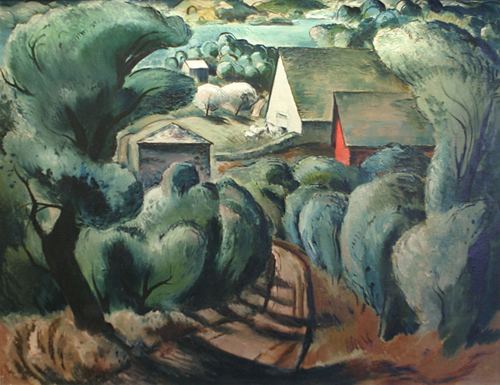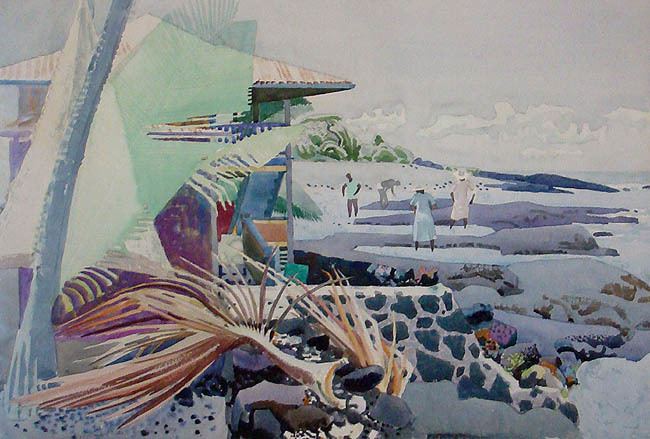Nationality American Name Millard Sheets | ||
 | ||
Full Name Millard Owen Sheets Known for Painting, Sculpture, Mosaics Died March 31, 1989, Gualala, California, United States | ||
Millard sheets and the farmer
Millard Owen Sheets (June 24, 1907 – March 31, 1989) was an American painter and a representative of the California School of Painting, later a teacher and educational director, and architectural designer of more than 50 branch banks in Southern California.
Contents
- Millard sheets and the farmer
- Millard sheets are 221 ol1 california art
- Early life and education
- Post educational career
- Millard Sheets Art Center
- Notable works
- References

Millard sheets are 221 ol1 california art
Early life and education

Millard Sheets was a native California artist who grew up in the Pomona Valley near Los Angeles. He attended the Chouinard Art Institute and studied with F. Tolles Chamberlin and Clarence Hinkle. While he was still a teenager, his watercolors were accepted for exhibition in the annual California Water Color Society shows. By 19 years of age, he was elected into membership. And at 20, even before his graduation from Chouinard, he was hired to teach watercolor painting.

In 1929, he won a second prize in the Texas Wildflowers Competitive Exhibitions, known for their generous awards. The prize money allowed Sheets to travel to Europe for a year to further his art education.
Post-educational career

By the early 1930s, he was well on his way to national recognition as a prominent American artist. He was exhibiting in Paris, New York, Pittsburgh, Chicago, Houston, St. Louis, San Antonio, San Francisco, Washington D.C., Baltimore, and many other cities throughout the United States. In Los Angeles, he was recognized as the leading figure and driving force behind the California Style watercolor movement.
Between 1935 and 1941, his recognition, awards, and output increased, winning him repeated mention in Art Digest and a color reproduction of his work in the book Eyes on America." In 1935, at age 28, he was the subject of a monograph published in Los Angeles. His art sales enabled him to travel to Europe, Central America, and Hawaii, where he painted on location. Although his watercolor techniques during this period ranged from very tight to very loose, a consistent, underlying personal style always came through.
During World War II, he was an artist-correspondent for Life magazine and the United States Army Air Forces in India and Burma. Many of his works from this period document scenes of famine, war, and death that he witnessed. That experience also informed his post-war art for a number of years. Many of his works from the 1940s, painted in California and Mexico, reflect this influence, especially where the color values were dark, the mood somber, and the subject matter depressing. After the 1950s, his style changed yet again, this time featuring brighter colors, often depicting subjects from his worldwide travels.
Watercolor and oil painting were only part of Sheets's art career. Through his teaching at Chouinard Art Institute, Otis Art Institute, Scripps College and other institutions, hundreds of artists learned how to paint, and were then guided into art careers. He directed the art exhibition at the Los Angeles County Fair for many years and brought world-class work to Southern California. During the Great Depression, he joined forces with Edward Bruce to hire artists for the Public Works of Art Project, the first New Deal art project during the Great Depression. In 1946, he served as a president of the California Water Color Society. In later years, he worked as an architect, illustrator, muralist, printmaker, and art exhibition juror.
Beginning in 1952, working directly for Howard F. Ahmanson, Sr., Sheets designed not only the mosaics for dozens of branch offices of Home Savings of America throughout California, but also the buildings that housed them. And for these projects, he coordinated contributions from other artists, such as sculptor Albert Stewart. Outside of California, he took on artwork commissions for the Detroit Public Library, the Mayo Clinic, the dome of the National Shrine in Washington, D.C., the University of Notre Dame Library, the Hilton Hotel in Honolulu, and the Mercantile National Bank in Dallas.
In 1953, Sheets was appointed Director of Otis Art Institute (later named Otis College of Art and Design). Under his leadership, the school's academic program was restructured to offer BFA and MFA degrees, as well as a newly created ceramics department, headed by Peter Voulkos. During that time, a ceramics building, a gallery, a library, and a studio wing were completed. By the time Sheets left Otis, in 1960, the look and direction of the college had changed dramatically. In 1997, the Library at Otis was named after him.
The Scottish Rite Masonic Temple on Wilshire Boulevard in Los Angeles, designed by Sheets and completed in 1961, but largely vacant since 1994, was refurbished in 2016 to house the Marciano Art Foundation museum. "Much of the original architectural detail is being preserved," the foundation said, "including three Sheets murals and the building’s exterior Italian marble statues of Egyptian and Roman gods, U.S. presidents, and other historical figures." The building, for decades "one of Los Angeles's most notorious real estate white elephants," was used as a location for the 2004 adventure film "National Treasure," starring Nicolas Cage, which revolved around a fictional long-running Masonic conspiracy.
Millard Sheets Art Center
The Millard Sheets Art Center first began as the Fine Arts Program of the Los Angeles County Fair in 1922. The 20,000+ square-foot art center was built in 1937 by the Works Progress Administration to house the program, the first major gallery dedicated solely to art in Los Angeles County. Each year, the gallery provided visitors to the Los Angeles County Fair with access to art work found throughout the world. In 1994 the building was dedicated to Millard Sheets and in 2013 was identified by Fairplex as the home for year-round art education and exhibitions and is currently a part of The Learning Centers at Fairplex.
